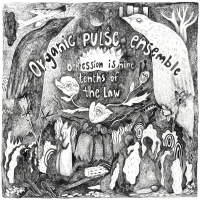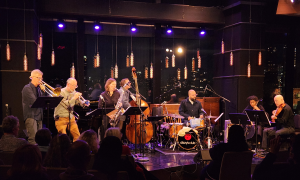Home » Jazz Articles » Live Review » Freihofer's Saratoga Jazz Festival 2023
Freihofer's Saratoga Jazz Festival 2023

Courtesy Richard Conde
The 46th festival at Saratoga Performing Arts Center pushed the meter toward excellent.
Saratoga Performing Arts Center
Saratoga Springs, New York
June 25-26, 2023
It seems routine over more than four decades to say that "this year's" edition of Freihofer's Saratoga Jazz Festival was a good one. Maybe you said it last year, maybe you'll say it next year.
That would certainly please festival producer Danny Melnick, who strives for consistency. Truth is, since its inception in 1978 (Melnick doesn't go back that far, iconic impresario George Wein created the event) some are better than others. None are bad, some years it leaned a little toward disappointment (probably the worst that's ever been said in Saratoga). Others ranged from good to excellent. The 46th festival at Saratoga Performing Arts Center pushed the meter toward excellent.
Four two days, the music was outstanding, covering various genres beyond jazz—as festivals must now do in order to survive—but in each case the level of musicianship was high and the performances were potent and energetic. It's presented on two stages. One is SPAC's main amphitheater stage, where rock and pop bands hold court throughout the summer season (as well as some orchestra and ballet sessions). The other stage is a small, though no less professional, at the rear of the scenic grounds. There is no musical demarcation. Excellence is continually displayed on both.
The festival's first amphitheater act on Day One bolted out of the gate and set the tone for the weekend. It was a no-holds-barred set by Cindy Blackman Santana and her group. The music was jazz fusion with an edge, raucous and driving, steered and stoked by Blackman's polyrhythmic drumming. She brought a helluva band that included Ravi Coltrane on reeds, David Gilmore on guitar, Felix Pastorius on bass and Zaccai Curtis on keyboards. Coltrane bounced from tenor to soprano sax for the most part, like his revered father, John. He's his own man, though, with a cleaner tone on soprano and his own robust, thick tenor voice. He played ethereal in spots and powerful in others, as the music required.
Blackman Santana is all over the kit, not playing 4/4 jazz ride beats, but pushing the music and nudging the soloists with her own propulsion. Elvin Jones, Louis Hayes—the entire legacy. She pulls from all and creates her personalized style.
Technically, about a half-hour earlier, Nduduzo Makhathini started the fest at the rear stage. The pianist from umGungundlovu in South Africa, led a trio through inspired jazz-meets-Africa compositions. He was eloquent when he talked to the crowd about the place of music in the world and, spiritually, in the cosmos. His playing had elements of Thelonious Monk in his heavy approach and his interesting way he approached melody and harmony. He even emphasized certain chords by thumping his forearm, percussively, on the keyboard (á la Monk). His dancing when bass and drums played was not Monk's idiosyncratic style. It came from his native land.
Other international flavoring came from the Cuban icon Chucho Valdes and singer Claudia Acuna from Chile. At age 81, Valdes is still a virtuoso pianist, his large hands thundering across the keys at times creating as much percussion as a drummer, and at other times playing arpeggios or delicacy and beauty., but always with a strong rhythm characterized by the music from his homeland. Acuna has the soft voice that hearkens to the bossa nova singers from Brazil and she did some of the material associated with that style of music. She is always joyful.
For mainstream fans there was Emmet Cohen, a young pianist who has been gaining in popularity both among fans and musicians, particularly singers, for his open ears, sensitivity to what is going on, and his prodigious sense of swing. He played some originals and covered the past, including a moving "Over the Rainbow."
Blues music is a must at jazz festivals and it struck like lightning this year with guitarist Carolyn Wonderland. The played in the scorching style thatTexans like her are known for and her voice is strong and powerful, piercing through the skies that were rainy at the time. Wonderland, who toured for a time as John Mayall's trusted guitar slinger, played new and familiar tunes, mostly high-energy, but she proved her mettle with torch songs as well and played some fine lap steel guitar as well. Janis Joplin's "What Good Can Drinkin' Do" was a favorite.
The amphitheater later on Saturday featured larger groups, each different. Tower of Power was a crowd pleaser, playing their brand of funk—and radio hits—with precision. Personnel has largely changed but not style. But the music was stale—a very professional reproduction of what once was, giving fans a chance to reminisce. The horns were tight. One could tap their feet, but there was not much for the head, and overall it was pale. There are worse things.
Guitarist Cory Wong also brought horns with his band. They were far more energetic, as the music was alive in the moment and so were they. They provided funk and soul and bright colors in music most people probably didn't know, but it didn't matter. They were more modern. It was fresh and stimulating. It also wasn't guitar-centric, though the leader is a sharp player and it could have gone that way. It was invigorating.
Snarky Puppy deserves the accolades they get. The orchestra is young and vibrant and the music reflects that. Soloists are jazzy and improvisation is high, but the band can get funky, or a little spacey, depending on the composition. The jazz is there, but sometimes pushed aside—deliberately—for explorations in another direction. Violin, guitar and horns mesh, then stray off. It's an interesting and satisfying experience.
Sunday brought the swingingest music in the form of the Skidmore Jazz Institute Faculty All-Stars. Skidmore College in Saratoga has an annual jazz camp attended by young music students. The faculty consists of A-list players like bassist Todd Coolman, trombonist Michael Dease, Jimmy Greene on sax, Bill Cunliffe on piano, guitarist Dave Stryker and trumpeter Clay Jenkins. It was billed as a tribute to Wes Montgomery, Tito Puente and Dexter Gordon, but that mattered little. It was strong, straight-ahead jazz with each soloist playing creatively, the rhythm completely in sync. Gordon's "Fried Bananas" stood out perhaps, but not a sour note was heard. That "ohhh yeah" feeling pervaded the set.
One of the volcanic appearances of the weekend was the young—but now highly decorated—Samara Joy and her trio. Her touring schedule is heavy and she's ubiquitous, but it was her debut at the Freihofer's festival. She held the audience in the palm of her hand.
Her stage presence and confidence have improved, as will happen with road warriors. Songs she's done many times took different paths—notes held here, bent there, a phrase altered here, harmony changed there. That's the essence of good jazz singing and she was taking pages very much from the book of Sarah Vaughan, though not exclusively. Her growing talent is amazing, given that she, now 23, only became familiar with jazz for the first time in college.
"Round Midnight," "Stardust," ""Linger Awhile," "If You Never Fall In Love" and were among the selections and pianist Luther Allison was very strong and impressive throughout. Particular pleasers were Betty Carter's "Tight" and "Guess Who I Saw Today," the poignant narrative ballad told from the perspective of a woman who stops for a quiet lunch and finds her husband in the quaint restaurant with another woman.
Also spectacular was pianist Hiromi with her new band Sonicwonder. She is a wonder. When she sits on the piano bench, one is apt to hear wondrous, classical influences, crazy jazz shops and the tenderest of sweet moments—maybe all in the same composition. Her chops are something to behold and the amount of time she must practice to develop them is unimaginable. She plays so hard, but in a way it almost seems effortless, even as the music shifts in intensity and style. A maelstrom of sounds gives way to whispers. The expressions of joy on her face that she exchanges with band members shows how much fun she is having. It spreads to the audience.
Pat Metheny and his Side-Eye trio gave its usual skillful performance, covering tunes from the great musical mind of the guitarist. Like Metheny, sidemen Joe Dyson on drums and keyboardist Chris Fishman had dazzling chops, which is the point of the Side-Eye group. Metheny keeps them in their spot, then lets go of the reins when necessary. He also played solo acoustic guitar—on a double-neck instrument—to open the show, showing a somewhat softer, though still dexterous, side of himself.
Bonnie Raitt was the festival closer, most likely booked to bring in those who might not otherwise attend a jazz festival. She still has it. Her voice is still strong and she's at home in blues and rock. Her slide guitar work may be limited, but the notes are always in the right place and she gets across the emotion of a song, which counts more than just straight razzle dazzle.
She did some hits like "Have a Heart" and "Something to Talk About," but also favored tunes by friends and cohorts John Hiatt and John Prine. There was a sense of melancholy at some points as she talked of people she has played with who are no longer around, and how the music scene has changed. One of her new compositions, "Ones Who Didn't Make It," illustrated that, but the pervasive feeling was "lets have fun" and people did.
It was another fine festival in the books.
Tags
Live Review
R.J. DeLuke
United States
Cindy Blackman Santana
Ravi Coltrane
David Gilmore
Felix Pastorius
Zaccai Curtis
Art Blakey
Elvin Jones
Peter Larocca Sims
Louis Hayes
Thelonious Monk
Chucho Valdes
Claudia Acuna
Emmet Cohen
Cory Wong
Todd Coolman
Michael Dease
Bill Cunliffe
Dave Stryker
Clay Jenkins
Wes Montgomery
Tito Puente
Dexter Gordon
Samara Joy
Sarah Vaughan
Hiromi
pat metheny
Bonnie Raitt
PREVIOUS / NEXT
Support All About Jazz
 All About Jazz has been a pillar of jazz since 1995, championing it as an art form and, more importantly, supporting the musicians who make it. Our enduring commitment has made "AAJ" one of the most culturally important websites of its kind, read by hundreds of thousands of fans, musicians and industry figures every month.
All About Jazz has been a pillar of jazz since 1995, championing it as an art form and, more importantly, supporting the musicians who make it. Our enduring commitment has made "AAJ" one of the most culturally important websites of its kind, read by hundreds of thousands of fans, musicians and industry figures every month.






















